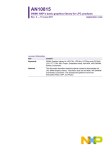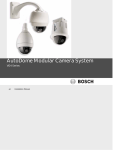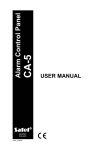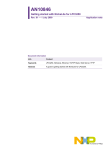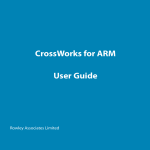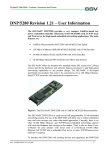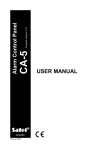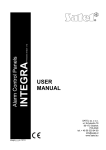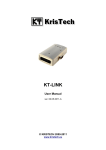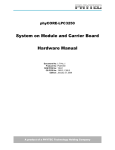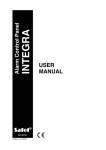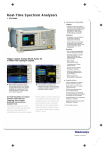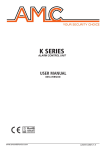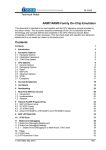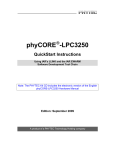Download PDF document - Eetasia.com
Transcript
AN10815 SWIM: NXP's basic graphics library for LPC products Rev. 01 — 1 May 2009 Application note Document information Info Content Keywords SWIM, Graphics Library for LPC24xx and LPC32X0, LCD, TFT, STN, IRD, Phytec, Embedded Artists, Keil MDK, IAR EWARM, Rowley Crossworks. Abstract This document describes example projects created to demonstrate the LPC SWIM Graphics library. Toolchains used are Keil MDK, IAR EWARM and Rowley Crossworks. The development platforms were from Embedded Artists, NXP, and Phytec. AN10815 NXP Semiconductors SWIM: NXP's basic graphics library for LPC products Revision history Rev Date Description 01 20090501 Initial revision Contact information For additional information, please visit: http://www.nxp.com For sales office addresses, please send an email to: [email protected] AN10815_1 Application note © NXP B.V. 2009. All rights reserved. Rev. 01 — 1 May 2009 2 of 15 AN10815 NXP Semiconductors SWIM: NXP's basic graphics library for LPC products 1. Introduction Simple Window Interface Manager (SWIM) is a basic graphics library developed for the NXP LPC products. It can be also be used with LPC controllers that do not have a dedicated LCD interface. The SWIM graphics library allows developers to quickly and easily implement a system with basic graphics support. Project examples for IAR EWARM, KEIL MDK, and Rowley Crossworks toolchains are provided as part of the package. These projects are directed at the following target platforms: • LPC3250 from Phytec: http://www.nxp.com/redirect/phytec.com • LPC2478 from EA: http://www.nxp.com/redirect/embeddedartists.com • IRD Platform from NXP: http://www.standardics.nxp.com/support/boards/ird The example projects demonstrate how to use the library and will help users get familiar with the library calls quickly and efficiently. 2. SWIM features The following section describes the main features and functionality of the SWIM library. In addition, the library code is well commented and an associated API document for the software calls - SWIM v1.0.pdf – is also available. Some of the main SWIM functions are briefly summarized in the following subsections. 2.1 Graphic primitives • swim_put_pixel – places a pixel of specified color at a specified location on the LCD • swim_put_line – draws a colored line for positions x to y • swim_put_diamond – draws a diamond shape of specified color and position • swim_put_box – put box at specified location. Pen color for edges and fill color for center • swim_set_pen_color – sets the pen color • swim_clear_screen – fills the draw area of the display with the selected color 2.2 Image support • swim_put_image – puts a raw image into a window • swim_put_scale_image – puts and scales a raw image into a window • swim_put_invert_image – puts a raw image into a window inverted 2.3 Font support • Helvetica 10-point proportional font • 8x16 proportional font • 8x8 proportional font • Fixed 5x7 proportional font • Windows FreeSystem 14x16 Font AN10815_1 Application note © NXP B.V. 2009. All rights reserved. Rev. 01 — 1 May 2009 3 of 15 AN10815 NXP Semiconductors SWIM: NXP's basic graphics library for LPC products 3. IRD platform The Industrial Reference Design (IRD) v2.0 is a platform targeted at RTOS based embedded systems. Designed around a flexible Core and Base printed circuit board (PCB) concept, it features many of the system functions and wired communications protocols found in today's embedded applications. The examples provided with this SWIM library are developed for use with the LPC2478 core board module. Fig 1. IRD platform 3.1 Description of IRD board setup The IRD 2.0 platform should come preassembled with the LPC2478 core board installed and the Toshiba LCD module attached. If not, refer to the IRD User’s Manual to assemble them properly. There are no jumpers to configure that affect the example code for this platform. The IRD 2.0 2478 board has either 8 MB, 16 MB, or 32 MB external SDRAM using a 64 Mbit, 128 Mbit, or 256 Mbit x 32 SDRAM device in U6 respectively: • MT48LC2M32B2 (64 Mbit SDRAM, 32-bit databus) from Micron (default) • MT48LC4M32B2 (128 Mbit SDRAM, 32-bit databus) from Micron (option) • MT48LC8M32B2 (256 Mbit SDRAM, 32-bit databus) from Micron (option) The supplied example is setup for the 64 Mbit (8 MB) Micron SDRAM configuration. For other versions of the core board it will be necessary to modify the SDRAM initialization code in the "ex_sdram.c" file. This SDRAM memory will be used as the LCD frame buffer memory for this example. The SDRAM memory resides at address: 0xA000 0000 - 0xA07F FFFFF using DYNCS0 (8 MB, 2Mx32) AN10815_1 Application note © NXP B.V. 2009. All rights reserved. Rev. 01 — 1 May 2009 4 of 15 AN10815 NXP Semiconductors SWIM: NXP's basic graphics library for LPC products Using the 240x320 16bpp RGB1:5:5:5 mode, the frame buffer uses 150 kB of SDRAM starting at address 0xA0000000. The parameters for the Toshiba LCD panel are configured in lcd_params.c; this panel is configured for operation in 1:5:5:5 mode. 3.2 Rowley project description 3.2.1 Description Draws color bars and text on the LCD using the SWIM library with LCD in RGB1:5:5:5 mode. 3.2.2 Required hardware IRD 2.0 2478 Evaluation board w/Toshiba LTA057A347F 5.7" 320x240 LCD module. 3.2.3 Required software Rowley CrossStudio for ARM v1.5 or newer. Rowley CrossConnect for ARM or other supported debugger. 3.2.4 Usage 1) Start Rowley CrossStudio for ARM and open the example solution file. Select File->Open Solution-> Open the following solution: LPC2478_SWIM_Example.hzp 2) Build the solution. Build->Build Solution 3) Attach your CrossConnect debugger to the IRD 2.0 board and PC, then connect to it. Targets->Connect USB CrossConnect for ARM 4) Download the program into flash. Debug->Start Debugging (F5) 5) Run the program! Debug->Go (F5) 3.3 IAR EWARM project description 3.3.1 Description Draws color bars and text on the LCD using the SWIM library with LCD in RGB1:5:5:5 mode. 3.3.2 Required hardware IRD 2.0 2478 Evaluation board w/Toshiba LTA057A347F 5.7" 320x240 LCD module 3.3.3 Required software IAR Embedded Workbench for ARM (EWARM) v5.x or newer 3.3.4 Usage 1) Start IAR Embedded Workbench for ARM and open the example workspace space. File->Open->Workspace... AN10815_1 Application note © NXP B.V. 2009. All rights reserved. Rev. 01 — 1 May 2009 5 of 15 AN10815 NXP Semiconductors SWIM: NXP's basic graphics library for LPC products Open the following workspace: 2478_swim_example.eww 2) Build the project. Project->Rebuild All 3) Attach your JLink JTAG unit to the EA-2478 board and PC. 4) Download the program into flash. Project->Download and Debug (Ctrl+D) 5) Run the program! Debug->Go (F5) 3.4 Keil MDK project description 3.4.1 Description Draws color bars and text on the LCD using the SWIM library with LCD in RGB1:5:5:5 mode. 3.4.2 Required hardware IRD 2.0 2478 Evaluation board w/Toshiba LTA057A347F 5.7" 320x240 LCD module. 3.4.3 Required software Keil uVision v3.x or newer. Code should compile on evaluation version. 3.4.4 Usage 1) Start Keil uVision3 for ARM and open the example project file. Project->Open Project... Open the following project: ea_lcd.Uv2 2) Build the project. Project->Build Target 3) Attach your ULink2 JTAG unit to the IRD 2.0 board and PC. 4) Download the program into flash. Debug->Start/Stop Debug Session (Ctrl+F5) 5) Run the program! Debug->Run (F5) 4. LPC2478 EA Board Embedded Artists' LPC2478 OEM Board (mounted on the QVGA OEM Base Board with touch panel) lets you get up-and-running quickly with NXP's ARM7TDMI LPC24xx microcontroller series. The OEM board has SODIMM format and is only 66x48 mm. All processor signals are available on the 200-pin connector for easy expansion. The board can be used in OEM applications, as well as for educational purposes, experiments, and prototype projects. AN10815_1 Application note © NXP B.V. 2009. All rights reserved. Rev. 01 — 1 May 2009 6 of 15 AN10815 NXP Semiconductors SWIM: NXP's basic graphics library for LPC products Fig 2. EA LPC2478 Platform 4.1 Description of EA LPC2478 board setup The EA-2478 board should come preassembled with the LPC2478 core board installed and the Truly LCD module attached. If not, refer to the EA-2478 User’s Manual to assemble them properly. The jumpers can be left in the default position when shipped from the factory. The jumpers on this board are not labeled with the standard “J1” labels but only descriptive labels. The ones that matter for the example projects are: • Int/Ext display – set to internal display • Enable LCD – installed • 16 bit / 24 bit RGB data – set to 16 bit • Backlight shutdown – removed • Enable JTAG – installed The EA-2478 board has either 32 MB or 16 MB of external SDRAM using a x16 or a x32 SDRAM device in U9 or U13 respectively: • K4S561632H-UC75 (256 Mbit SDRAM, 16-bit databus) from Samsung (LPC2478-16 OEM Board) • K4M563233G-HN75 (256 Mbit Mobile SDRAM, 32-bit databus) from Samsung (v1.0 of LPC2478-32 OEM Board) • MT48LC8M32B2B5-7 (256 Mbit SDRAM, 32-bit databus) from Micron (v1.1a of LPC2478-32 OEM Board) This example is setup for the x32 Micron SDRAM configuration, v1.1a of the LPC247832 core board. For other versions of the core board it may be necessary to modify the SDRAM initialization code in the "ex_sdram.c" file. The SDRAM memory will be used as the LCD frame buffer memory for this example. The SDRAM memory resides at address: AN10815_1 Application note © NXP B.V. 2009. All rights reserved. Rev. 01 — 1 May 2009 7 of 15 AN10815 NXP Semiconductors SWIM: NXP's basic graphics library for LPC products • 0xA0000000 - 0xA1FFFFFF using DYNCS0 (32 MB, 8Mx32) In 240x320 16bpp RGB1:5:5:5 mode, the frame buffer uses 150 kB starting at: • 0xA0000000 within the SDRAM. The Truly LCD module on the EA-2478 board contains a complete LCD controller module with its own frame buffer as well as a hardware touchscreen controller. The example presented disables the LCD controller and frame buffer on the Truly module and places the LCD module into a dumb RGB1:5:5:5 mode. The SPI interface to the module is used to program the module into this mode. The parameters for the Truly LCD panel are configured in lcd_params.c. 4.2 Rowley project description 4.2.1 Description Draws color bars on the LCD using the SWIM library with LCD in RGB1:5:5:5 mode. 4.2.2 Required hardware EA-2478 Evaluation board w/Truly LCD module in RGB1:5:5:5 mode Rowley CrossConnect for ARM or other supported debugger 4.2.3 Required software Rowley Crossworks for ARM v1.5 or newer 4.2.4 Usage 1) Start Rowley CrossStudio for ARM and open the example solution file. Select File->Open Solution Open the following solution: EAC2478_SWIM_Example.hzp 2) Build the solution. Build->Build Solution 3) Attach your CrossConnect debugger to the EA-2478 board and PC, then connect to it. Targets->Connect USB CrossConnect for ARM 4) Download the program into flash. Debug->Start Debugging (F5) 5) Run the program! Debug->Go (F5) 4.3 IAR EWARM project description 4.3.1 Description Draws color bars on the LCD using the SWIM library with LCD in RGB1:5:5:5 mode. 4.3.2 Required hardware EA-2478 Evaluation board w/Truly LCD module 4.3.3 Required software IAR Embedded Workbench for ARM (EWARM) v5.x or newer AN10815_1 Application note © NXP B.V. 2009. All rights reserved. Rev. 01 — 1 May 2009 8 of 15 AN10815 NXP Semiconductors SWIM: NXP's basic graphics library for LPC products 4.3.4 Usage 1) Start IAR Embedded Workbench for ARM and open the example workspace space. File->Open->Workspace... Open the following workspace: ea2478_swim_example.eww 2) Build the project Project->Rebuild All 3) Attach JLink JTAG unit to the EA-2478 board and PC 4) Download the program into flash Project->Download and Debug (Ctrl+D) 5) Run the program! Debug->Go (F5) 4.4 Keil MDK project description 4.4.1 Description Draws color bars and text on the LCD using the SWIM library with LCD in RGB1:5:5:5 mode. 4.4.2 Required hardware EA-2478 Evaluation board w/Truly LCD module. 4.4.3 Required software Keil uVision v3.x or newer. Tested with Evaluation version of MDK. 4.4.4 Usage 1) Start Keil uVision3 for ARM and open the example project file. Project->Open Project... Open the following project: ea_lcd.Uv2 2) Build the project. Project->Build Target 3) Attach ULink2 JTAG unit to the EA-2478 board and PC . 4) Download the program into flash. Debug->Start/Stop Debug Session (Ctrl+F5) 5) Run the program! Debug->Run (F5) 5. LPC3250 Phytec The LPC3250 Phytec system is made up from three boards: the phyCOREARM9/LPC3250 System on Module (PCM-040), the phyCORE-ARM9/LPC3250 Carrier Board (PCM-967), and a optional add-on LCD - Hitachi 3.5" QVGA TFT-LCD with integrated touch on adapter board (KLCD-011). The complete system is shown in Fig 3. AN10815_1 Application note © NXP B.V. 2009. All rights reserved. Rev. 01 — 1 May 2009 9 of 15 AN10815 NXP Semiconductors SWIM: NXP's basic graphics library for LPC products Fig 3. Phytec LPC3250 Platform The phyCORE-LPC3250 module is populated with the NXP LPC3250. State-of-the-art power management, Vector Floating Point Unit (VFP), and rich peripherals such as USB OTG, Ethernet, and integrated LCD controller make this device the ideal candidate for embedded applications requiring high performance and low power consumption. The onboard MMU supports major operating systems, including Linux and Windows Embedded CE. Other chip-level features include 7 UARTs, SPI, I2C, a real-time clock with a separate power domain, and NAND Flash and DDR memory controllers. These features make the devices particularly suitable for automotive and industrial control applications as well as medical systems. 5.1 Description of Phytec board setup The LPC3250 Phytec is shipped with a preinstalled bootloader called the stage 1 loader (S1L). It is assumed that this is present on the board. The S1L first initializes the board with the code from the phy3250_startup_entry.s and phy3250_startup.c files before starting the monitor program. Without this initialization the colorbar example will not run. Be sure to configure your system defines in phy3250_board.h to match your hardware revisions. Failure to properly set these defines to the correct value may prevent the code from working correctly. The possible define values are below: • PHY3250_CARRIERBOARD_1305_X • PHY3250_MODULEBOARD_1304_X • PHY3250_LCD_1307_X LCD modules have a board number of 1307.x, where x = 0 or 1. The change between .0 and .1 LCD module is detailed below: LCD module revision differences: .0 initial board .1 Active HIGH backlight signal, different wiring Because of differences in the connector wiring of ‘.0’ and ’.1’ LCD modules, the ‘.0’ LCD modules should only be used with ‘.0’ carrier boards, while ‘.1’ LCD modules should only be used with ’.2’ or greater carrier boards. AN10815_1 Application note © NXP B.V. 2009. All rights reserved. Rev. 01 — 1 May 2009 10 of 15 AN10815 NXP Semiconductors SWIM: NXP's basic graphics library for LPC products Carrier boards have a revision number of 1305.x, where x = 0 to 3. The changes between the boards module are shown below: Carrier board revision differences: .0/.1 Initial board .2/.3 USB peripheral VBUS routed to USB_VBUS signal .2/.3 GPI4 used to VBUS detection for USB peripheral .2/.3 USB_ADR/SW used to control USB_ host power Module boards have a revision number of 1304.x, where x = 0 to 1. The changes between the module boards module are shown below: Module board revision differences: .0 Initial board .1 USB ISP1301 I2C address changed from 0x2C to 0x2D For correct jumper settings please refer to the PHYTEC phyCORE-LPC3250 System on Module and Carrier Board Hardware Manual. The phyCORE-LPC3250 board comes preconfigured with 64 MB of 133 MHz SDR SDRAM configured for 32-bit access using two 16-bit wide RAM chips at U10 and U11. The LPC3250 is capable of addressing a single RAM bank located at memory address 0x8000 0000 and extending to 0x9FFF FFFF via the /DYCS0 signal. The LCD is a Hitachi TX09D71VM1CCA. In 240x320 16bpp RGB565 mode the frame buffer uses 150kB starting at: 0x8000 0000 within the SDRAM. The parameters for the Hitachi LCD panel are configured in lpc_lcd_params.c 5.2 Keil MDK project description 5.2.1 Description Draws color bars and text on the LCD using the SWIM library with LCD in RGB1:5:6:5 mode. 5.2.2 Required hardware LPC3250 Phytec board with LCD. 5.2.3 Required software Keil uVision v3.x or newer. Tested with Evaluation version of MDK. 5.2.4 Usage The code is setup to execute from IRAM (Debug version) of the LPC3250. 1) Start Keil uVision3 for ARM and open the example project file Project->Open Project... 2) Build the project Project->Build Target 3) Attach ULink2 JTAG unit to the Phytec board and PC 4) Download the program Debug->Start/Stop Debug Session (Ctrl+F5) AN10815_1 Application note © NXP B.V. 2009. All rights reserved. Rev. 01 — 1 May 2009 11 of 15 AN10815 NXP Semiconductors SWIM: NXP's basic graphics library for LPC products 5) Run the program! Debug->Run (F5) For instructions on how to load the code into NAND Flash (Release version) please refer to the documents in the LPC3250 Common Driver Library package which can be downloaded at www.nxp.com/microcontrollers. Keil also provides a NAND Flash bootloader which can be used to download the code in to NAND flash. Refer to the Keil documentation/examples on how to save and execute the code from NAND flash. 5.3 IAR EWARM project description 5.3.1 Description Draws color bars and text on the LCD using the SWIM library with LCD in RGB1:5:6:5 mode. 5.3.2 Required hardware LPC3250 Phytec board with LCD. 5.3.3 Required software The project was developed using IAR Embedded Workbench ARM v5.x or newer. The IAR Evaluation version will also work. 5.3.4 Usage The code is setup to execute from IRAM (Debug version) of the LPC3250. 1) Start EWARM and open the example project file. Project->Open Project. 2) Build the project. Project->Build Target 3) Attach JLINK JTAG unit to the Phytec board and PC. 4) Download the program. Debug->Start/Stop Debug Session (Ctrl+F5) 5) Run the program! Debug->Run (F5) For instructions on how to load the code into NAND Flash (Release version) please refer to the documents in the LPC3250 Common Driver Library package which can be downloaded at www.nxp.com/microcontrollers. IAR also provides a NAND Flash bootloader which can be used to download the code in to NAND flash. Refer to the IAR documentation/examples on how to save and execute the code from NAND flash. 5.4 Rowley project description Currently Rowley Crosswork does not support the NXP LPC3250 microcontroller. AN10815_1 Application note © NXP B.V. 2009. All rights reserved. Rev. 01 — 1 May 2009 12 of 15 AN10815 NXP Semiconductors SWIM: NXP's basic graphics library for LPC products 6. Miscellaneous 6.1 RGB setting The SWIM RGB format will need to be adapted depending on the format supported by the LCD and the manner in which the LCD is connected to the LPC controller. For the Phytec board, the LCD uses RGB565 while the EA and IRD systems use RGB555. In the file “lpc_colors.h” set the RGB for the particular format as shown below: For Phytec LPC3250 Board: #define COLORS_DEF 16 /* 16-bit 565 color mode */ For EA LPC2478 and IRD boards: #define COLORS_DEF 15 /* 15-bit 555 color mode */ The SWIM library will can also be used to manipulate and display Bitmaps. 6.2 Demo output The snapshot in Fig 4 shows the resulting LCD panel look and feel when the code is run on the different platforms. The image in this case is taken from the EA LPC2478 Board. Fig 4. Phytec LPC3250 platform AN10815_1 Application note © NXP B.V. 2009. All rights reserved. Rev. 01 — 1 May 2009 13 of 15 AN10815 NXP Semiconductors SWIM: NXP's basic graphics library for LPC products 7. Legal information 7.1 Definitions Draft — The document is a draft version only. The content is still under internal review and subject to formal approval, which may result in modifications or additions. NXP Semiconductors does not give any representations or warranties as to the accuracy or completeness of information included herein and shall have no liability for the consequences of use of such information. 7.2 Disclaimers General — Information in this document is believed to be accurate and reliable. However, NXP Semiconductors does not give any representations or warranties, expressed or implied, as to the accuracy or completeness of such information and shall have no liability for the consequences of use of such information. Right to make changes — NXP Semiconductors reserves the right to make changes to information published in this document, including without limitation specifications and product descriptions, at any time and without notice. This document supersedes and replaces all information supplied prior to the publication hereof. Suitability for use — NXP Semiconductors products are not designed, authorized or warranted to be suitable for use in medical, military, aircraft, space or life support equipment, nor in applications where failure or malfunction of a NXP Semiconductors product can reasonably be expected to result in personal injury, death or severe property or environmental damage. NXP Semiconductors accepts no liability for inclusion and/or use of NXP Semiconductors products in such equipment or applications and therefore such inclusion and/or use is for the customer’s own risk. Applications — Applications that are described herein for any of these products are for illustrative purposes only. NXP Semiconductors makes no representation or warranty that such applications will be suitable for the specified use without further testing or modification. Export control — This document as well as the item(s) described herein may be subject to export control regulations. Export might require a prior authorization from national authorities. 7.3 Trademarks Notice: All referenced brands, product names, service names and trademarks are property of their respective owners. AN10815_1 Application note © NXP B.V. 2009. All rights reserved. Rev. 01 — 1 May 2009 14 of 15 AN10815 NXP Semiconductors SWIM: NXP's basic graphics library for LPC products 8. Contents 1. 2. 2.1 2.2 2.3 3. 3.1 3.2 3.2.1 3.2.2 3.2.3 3.2.4 3.3 3.3.1 3.3.2 3.3.3 3.3.4 3.4 3.4.1 3.4.2 3.4.3 3.4.4 4. 4.1 4.2 4.2.1 4.2.2 4.2.3 4.2.4 4.3 4.3.1 4.3.2 4.3.3 4.3.4 4.4 4.4.1 4.4.2 4.4.3 4.4.4 5. 5.1 5.2 5.2.1 5.2.2 5.2.3 Introduction .........................................................3 SWIM features......................................................3 Graphic primitives ..............................................3 Image support ....................................................3 Font support .......................................................3 IRD platform.........................................................4 Description of IRD board setup ..........................4 Rowley project description .................................5 Description .........................................................5 Required hardware.............................................5 Required software ..............................................5 Usage.................................................................5 IAR EWARM project description ........................5 Description .........................................................5 Required hardware.............................................5 Required software ..............................................5 Usage.................................................................5 Keil MDK project description ..............................6 Description .........................................................6 Required hardware.............................................6 Required software ..............................................6 Usage.................................................................6 LPC2478 EA Board..............................................6 Description of EA LPC2478 board setup............7 Rowley project description .................................8 Description .........................................................8 Required hardware.............................................8 Required software ..............................................8 Usage.................................................................8 IAR EWARM project description ........................8 Description .........................................................8 Required hardware.............................................8 Required software ..............................................8 Usage.................................................................9 Keil MDK project description ..............................9 Description .........................................................9 Required hardware.............................................9 Required software ..............................................9 Usage.................................................................9 LPC3250 Phytec ..................................................9 Description of Phytec board setup ...................10 Keil MDK project description ............................11 Description .......................................................11 Required hardware...........................................11 Required software ............................................11 5.2.4 5.3 5.3.1 5.3.2 5.3.3 5.3.4 5.4 6. 6.1 6.2 7. 7.1 7.2 7.3 8. Usage ...............................................................11 IAR EWARM project description.......................12 Description .......................................................12 Required hardware...........................................12 Required software ............................................12 Usage ...............................................................12 Rowley project description................................12 Miscellaneous ....................................................13 RGB setting ......................................................13 Demo output.....................................................13 Legal information ..............................................14 Definitions.........................................................14 Disclaimers.......................................................14 Trademarks ......................................................14 Contents .............................................................15 Please be aware that important notices concerning this document and the product(s) described herein, have been included in the section 'Legal information'. © NXP B.V. 2009. All rights reserved. For more information, please visit: http://www.nxp.com For sales office addresses, email to: [email protected] Date of release: 1 May 2009 Document identifier: AN10815_1















